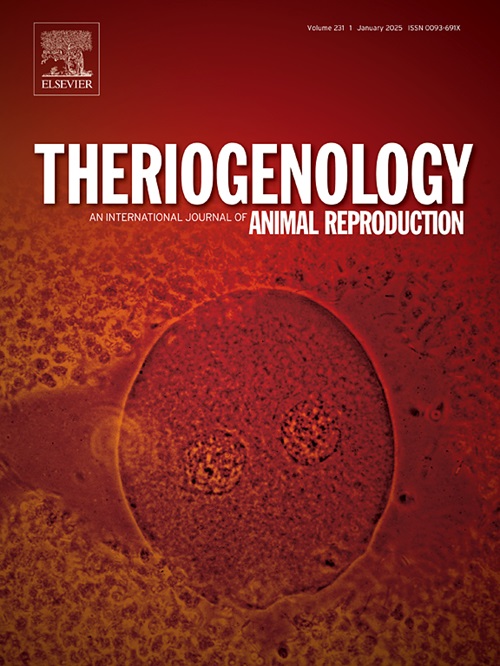Reproduction control in a feral feline population using an anti-GnRH vaccine
IF 2.4
2区 农林科学
Q3 REPRODUCTIVE BIOLOGY
引用次数: 0
Abstract
This study aimed to evaluate the use of the Improvac® vaccine to avoid heat and pregnancies in queens and fertility in males during the breeding season. Twenty-eight intact animals were divided into treated males (G1, n = 7), treated females (G2, n = 18), and untreated males (G3, n = 3) that were untamed and could not be captured for immunization. In cats from the G1 group, the testicular volume (337.35 ± 95.74 mm3) and testosterone concentration (1.31 ± 0.49 ng/mL) reached the lowest value 16 weeks after the first vaccination. At week 40, all queens exhibited both estrus cytology and estrus behavior, with serum estrogen (38.5 ± 1.93 pg/mL) and progesterone (0.5 ng/mL) concentrations within the physiological range for the phase. Eleven queens received a third dose of the vaccine at week 40, and none became pregnant by week 64. The remaining queens (n = 7) did not receive the third dose of the vaccine and became pregnant by week 44. In cats from the G1 and G2 groups, the hematologic parameters were within the physiological range for the species. The results of this study indicate that the Improvac® vaccine is safe and effective in the short to medium term in preventing cat reproduction.
求助全文
约1分钟内获得全文
求助全文
来源期刊

Theriogenology
农林科学-生殖生物学
CiteScore
5.50
自引率
14.30%
发文量
387
审稿时长
72 days
期刊介绍:
Theriogenology provides an international forum for researchers, clinicians, and industry professionals in animal reproductive biology. This acclaimed journal publishes articles on a wide range of topics in reproductive and developmental biology, of domestic mammal, avian, and aquatic species as well as wild species which are the object of veterinary care in research or conservation programs.
 求助内容:
求助内容: 应助结果提醒方式:
应助结果提醒方式:


